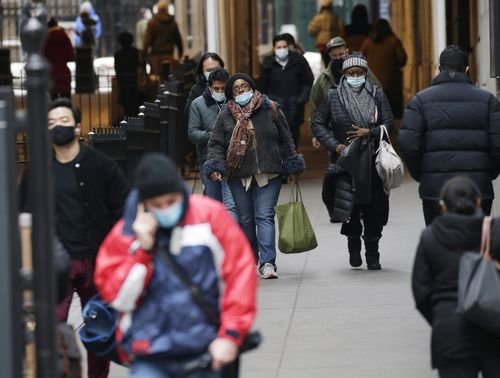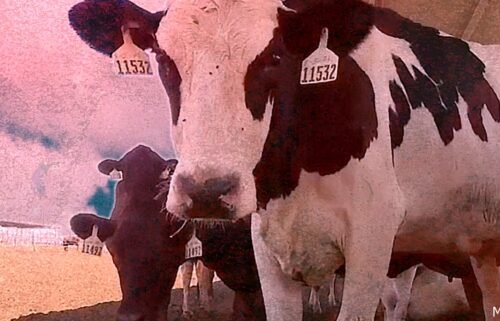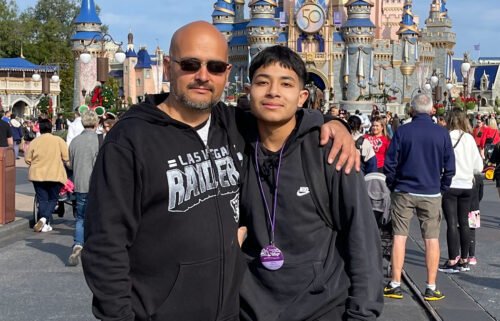US needs to hold on for another 2 or 3 months without easing Covid-19 measures, experts say. Here’s what’s at stake

Americans have received some good news lately about the coronavirus. But the country is not yet in the clear, experts warn.
A third Covid-19 vaccine — Johnson & Johnson’s single shot — is now on its way to states across the country. And Covid-19 cases and hospitalizations have generally been dropping for weeks.
But case levels are still as high as the worst part of last summer, and the recent rate of decline appears to have slowed. More transmissible variants are spreading.
So several experts are pleading: Hang on to safety measures at least a few months longer while vaccinations pick up — or watch cases soar right back.
“This is not a time to relax restrictions — especially the governors who are all high-fiving themselves saying we’re out of this. We’re not,” Dr. Peter Hotez, co-director of the Center for Vaccine Development at Texas Children’s Hospital, said Tuesday.
“Especially when we have vaccines coming … just hold off another couple of months, and that’s going to be such a game changer. We could save so many lives right now if we were to just adhere to (restrictions) for a bit longer, until we could fully vaccinate,” Hotez told CNN’s “New Day.”
Dr. Zeke Emanuel, who was a member of the Biden Transition Covid-19 Advisory Board, told CNN something similar Monday.
“We should not ease up, allow indoor dining, big groups … getting rid of mask mandates. We have to hold on for another two or three months in this condition,” Emanuel said. “We’re still having, on average, 2,000 (Covid-19) deaths a day. We cannot become inured to that.”
If Americans relax too early, Covid-19 numbers are “going to reverse and go up,” he added.
Highly transmissible variants that threaten to create another surge in the US include the B.1.1.7 strain, which was first identified in the UK. The CDC warns it could become the predominant variant in the US this month.
Still, several state leaders have been easing Covid-19 restrictions, and more joined them Monday.
Kentucky Gov. Andy Beshear said many businesses can increase capacity to 60% — including barbershops and hair salons, bars and restaurants, bowling alleys, fitness centers, movie theaters and government offices.
Pennsylvania state officials announced they had revised maximum-occupancy limits for indoor and outdoor events and eliminated out-of-state travel restrictions. And in Chicago, officials said Tuesday they will allow restaurants to operate indoors at the lesser of 50% capacity or 50 people, raising the previous limit of 40%.
Dr. Ashish Jha, dean of the Brown University School of Public Health, said these moves are coming at the wrong time.
“We’ve got states easing restrictions — which they should not be doing at this moment — and we’ve got the variants that are circulating that are a lot more infectious. Put all that together, and (I) can’t help but worry about where we’re going to be for the next couple of months,” Jha said Tuesday.
‘We’re not in great shape’ with case numbers similar to last summer
The University of Minnesota’s Center for Infectious Disease Research and Policy recently warned the proportion of cases of the B.1.1.7 variant was rapidly increasing in parts of the US and a “major peak in cases, hospitalizations and deaths in the near future remains a strong possibility.”
Covid-19 cases, hospitalizations and deaths have declined over many weeks, though some numbers have recently wobbled, and experts say they are still high contextually:
— Cases: The US has averaged about 67,760 new cases a day over the last week — far below the nation’s pandemic peak average of more than 249,700 daily on January 8, according to Johns Hopkins University.
The rate of decline recently slowed — the average was just above 70,000 a week ago, and it even rose a bit before falling again late last week. Some of that may be attributable to stalled case reporting by some states hit by severe winter storms last month.
But the current average still is above the worst average seen last summer: around 67,030 on July 20.
“So we’re not in great shape,” and if highly contagious variants take hold from this level, “I think we can absolutely see a huge spike that will really lead to a lot more suffering,” Jha said.
— Hospitalizations: More than 46,700 Covid-19 patients were in US hospitals on Monday — the lowest number since October 29, according to the COVID Tracking Project
— Deaths: The country has averaged 2,046 Covid-19 deaths a day across the last week — a number that has hovered above and below 2,000 for the past couple of weeks. The country is nearly seven weeks removed from its peak daily average of 3,354, according to Johns Hopkins data.
First J&J doses are shipped
States are expecting to receive their first doses of the Johnson & Johnson vaccine this week, days after the Food and Drug Administration issued an emergency use authorization for it.
About 3.9 million doses of this one-shot vaccine will be distributed in this initial wave of shipments, with a goal to ship 20 million doses by the end of the month, the White House has said.
President Joe Biden is expected to announce Tuesday that another company — Merck & Co. — will partner with Johnson & Johnson to help manufacture its vaccine, potentially speeding production, administration officials familiar with the matter told CNN. The planned partnership was first reported by the Washington Post.
Before now, the only Covid-19 vaccines authorized in the US — from Pfizer/BioNtech and Moderna — have been two-dose products.
Three Federal Emergency Management Agency vaccination sites in Texas are expected to receive about 24,000 doses of the Johnson & Johnson vaccine Tuesday, according to Lara Anton, press officer for the Texas Department of State Health Services. It’s unclear if doses will also be administered Tuesday.
More than 200,000 Johnson & Johnson doses are expected to be available to the state for next week’s allocation, Anton said.
In Houston, Mayor Sylvester Turner said he expects the first delivery of the Johnson & Johnson vaccine Tuesday.
“It certainly will be the best option for our transient populations,” he said of the one-dose vaccine. “For example, our homeless population, which is very difficult to get back for their second shot.”
Track US Covid-19 vaccinations here
In Colorado, health officials said they expect to receive more than 45,000 doses of the Johnson & Johnson vaccine by Friday.
The authorization of the vaccine will “make it easier for the state to reach its vaccination goals as more people become eligible in the weeks to come,” said Dr. Eric France, the chief medical officer for the Colorado Department of Public Health and Environment.
Ohio Gov. Mike DeWine announced the state will receive more than 96,000 doses of the vaccine this week, boosting the state’s total number of doses expected this week to more than 448,000.
Because of the additional doses, DeWine said the state will be expanding its vaccine eligibility to Phase 1C on March 4: people who are living with Type 1 diabetes, are pregnant, are bone marrow transplant recipients or living with ALS, as well as people working in childcare services, funeral services and law enforcement and corrections officers.
The state will also start its Phase 2 on the same day, lowering age eligibility to people 60 or older.
Across the US, more than 51.7 million people have so far received at least their first dose of a Covid-19 vaccine, according to CDC data. More than 26.1 million have received both doses.




